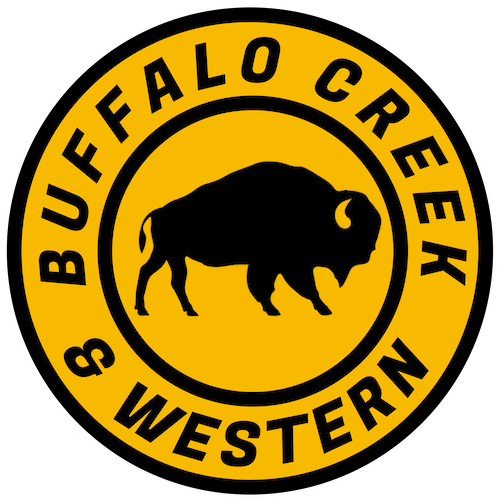Buffalo Creek & Western Railroad (BC&W) History
“Serving Montana’s Heartland Since 1979”
HQ: Maple Hollow, Montana
Length: ~50 miles
Interchange: Burlington Northern – Maple Hollow, MT
Primary Commodities: Wheat, barley, fertilizers, livestock feed, propane, lumber, malt
Overview
The Buffalo Creek & Western (BC&W) is a 50-mile shortline in north-central Montana, running west and south from its Burlington Northern interchange at Maple Hollow, a fictional town replacing Power along the BN line between Shelby and Great Falls.
The BC&W connects a diverse mix of grain elevators, feed mills, fertilizer dealers, propane distributors, and a malting plant with the national rail network. While grain dominates the traffic base, inbound agricultural supplies, lumber reloads, and processed malt provide steady year-round shipments.
The railroad takes its name from Buffalo Creek, a small prairie stream flowing near Maple Hollow and through much of the line’s territory.

Origins
The BC&W was incorporated in 1979, after Burlington Northern announced plans to abandon its lightly used former Great Northern branch lines extending west to Choteau and south to Fairfield.
Originally built in the 1910s, the branches connected scattered farming communities and grain shippers to the GN main line. By the late BN years, deferred maintenance and shrinking traffic threatened the line’s survival.
A coalition of local cooperatives, grain companies, agricultural suppliers, and county officials purchased the route, forming the Buffalo Creek & Western Railroad. The effort ensured continued rail service for area farmers and honored a vanished settlement remembered in local history, giving the line its name.
Industries Served
Maple Hollow (BN Interchange)
- Maple Hollow Farmers Co-op – Major terminal facility with a wooden elevator, annex bins, grain dryer, fertilizer bins, and a small feed mill.
- Anderson Grain Co. – Independent elevator founded in 1938, still operating its original house with one annex bin.
- Prairie Valley Grain – Private elevator with steel bins and dual tracks, known for high-capacity grain handling.
Mid-Branch Communities
- Northern Montana Farm Supply – Dealer handling inbound fertilizer, bulk seed, and farm equipment.
- Frontier Propane – Propane distributor with bulk storage tanks and a transload facility for local delivery.
- Big Sky Lumber – Reload yard for dimensional lumber and plywood, distributing to regional hardware stores.
Fairfield (Southern Terminus)
- Three Rivers Grain Co. – Large cooperative elevator complex serving as a major outlet for wheat and barley.
- High Plains Milling – Small flour and feed mill producing for local markets.
Choteau (Western Terminus)
- Clearwater Malting Co. – Malting plant producing barley malt for Montana and Pacific Northwest breweries.
- Choteau Farmers Exchange – Older wooden elevator with annexes, serving surrounding grain farms.
Operations
The BC&W’s traffic is anchored by outbound wheat and barley shipments in covered hoppers, destined for domestic milling and export markets. Inbound fertilizer, livestock feed ingredients, seed, propane, and farm machinery keep cars moving year-round.
Lumber reloads from Big Sky Lumber and malt shipments from Clearwater Malting diversify the traffic base beyond grain.
During harvest season, grain dominates operations, with long cuts of covered hoppers filling interchange tracks at Maple Hollow.
Motive Power Roster (1985)
- BC&W #171 – EMD GP9, built for Great Northern (road no. 688) in 1956, later BN 1761. Purchased from BN in 1979 and rebuilt for short-hood-forward operation.
- BC&W #1562 – EMD GP15-1, built for Missouri Pacific in 1976. Acquired secondhand in 1984 to handle peak-season grain traffic and provide backup power.
Both locomotives are maintained and refueled at Maple Hollow, using a designated track in the BN interchange yard equipped with a small fuel tank and tool shed.
Burlington Northern Connection
Location & Facilities
At Maple Hollow, the BC&W interchanges with Burlington Northern on the main line between Shelby and Great Falls.
Facilities at Maple Hollow include:
- A short yard track for holding BC&W interchange traffic.
- A hand-throw crossover linking the BC&W spur to BN’s main yard lead.
- A modest office building used primarily for yard clerks and paperwork.
- A designated track used by the BC&W for light locomotive servicing and refueling, equipped with a small fuel tank and basic tool shed.
The interchange track also doubles as BC&W’s staging point for outbound loads and inbound empties.
Role in Grain Routing
BN plays a crucial role in moving the BC&W’s grain traffic to larger markets. Outbound hoppers from Maple Hollow, Choteau, and Fairfield typically move north to Shelby or south to Great Falls, where they are gathered into longer BN trains bound for:
- Pacific Northwest ports (Seattle, Tacoma, Portland) for export.
- Midwestern milling markets via BN’s Class I connections.
Inbound fertilizer and feed ingredient shipments to BC&W customers originate from:
- The Gulf Coast and Midwest (fertilizer plants in Louisiana, Iowa, and Illinois).
- Pacific Northwest ports for imported products.
- Propane shipments typically arrive from regional refineries or distribution hubs.

Typical Car Types Handled at Maple Hollow Interchange
- Covered Hoppers – predominately 2-bay and 3-bay cars for grain, fertilizer, and feed ingredients.
- Tank Cars – occasional inbound loads of propane and liquid fertilizers.
- Boxcars – sporadic shipments of bagged seed, feed, or machinery parts.
- Flatcars – occasional inbound farm equipment.
Car Ownership & Markings
Most covered hoppers are in BN’s Cascade green (including repainted NP, GN, and CB&Q heritage cars). Private-owner marks such as GATX, SHPX, and Cargill (CGLX) are common, with foreign road cars from Soo Line, Milwaukee Road, and Union Pacific appearing at harvest peaks.
Traffic Frequency
During peak harvest (late August through October), the BC&W may deliver 10–16 loaded hoppers to BN in a single day. Inbound fertilizer and feed shipments typically arrive in smaller cuts of 2–4 cars, timed with spring planting or mid-season restocking. Propane deliveries occur steadily but in small numbers, while shipments of farm machinery, seed, or bagged feed appear only occasionally.
Header photo by Dawid Zawiła
